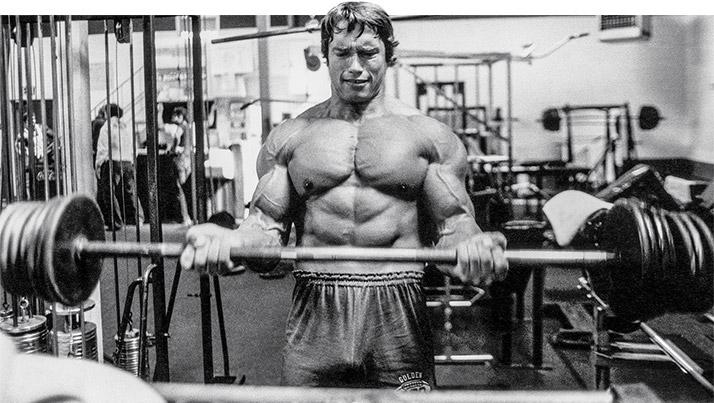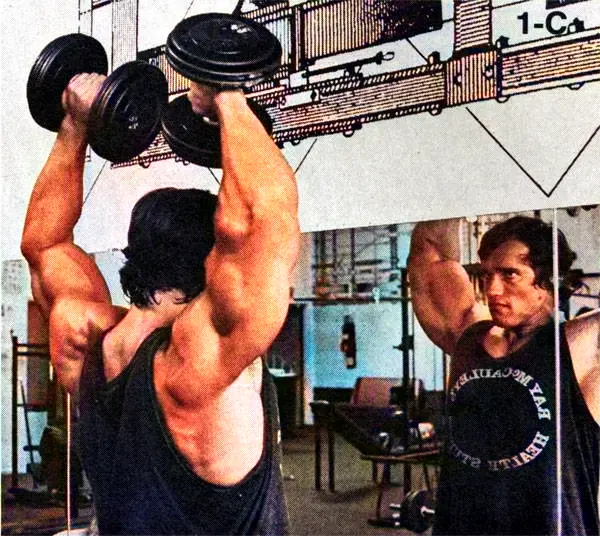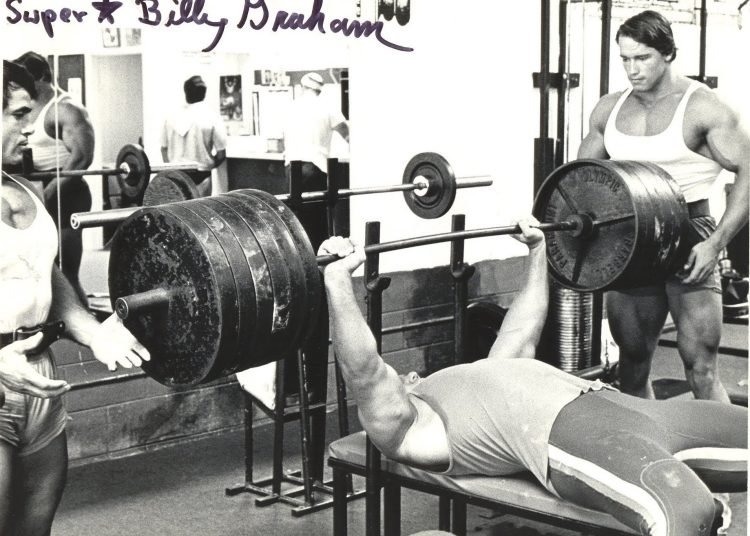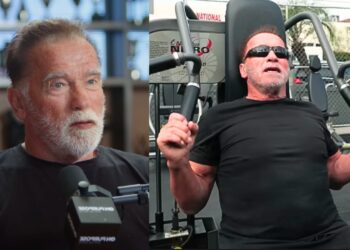Arnold Schwarzenegger is a hero to many people. As a 7-time Mr. Olympia winner, he inspired a generation of bodybuilders to start pumping iron, and his movies have kept his legion of fans entertained for more than 40 years.
Despite being in his late 70s, Arnold continues to spread the fitness message in his weekly newsletter, aptly titled Arnold’s Pump Club. In addition, he has a popular podcast and workout app.
Throughout his bodybuilding and movie career, and now for longevity and health, Arnold has followed countless workout routines. However, he’s probably best known for his high-frequency, high-volume approach to bodybuilding.
Related: Arnold Schwarzenegger Volume Workout Routines
Of these workouts, the Arnold Blueprint to Mass is probably the most famous, and many lifters have used it to build muscle and strength. It’s a classic training program that is ideal for intermediate and advanced exercisers looking to follow in Schwarzenegger’s footsteps.
However, following the Arnold Blueprint to Mass means you’ll need access to a well-equipped gym.
Level Up Your Fitness: Join our 💪 strong community in Fitness Volt Newsletter. Get daily inspiration, expert-backed workouts, nutrition tips, the latest in strength sports, and the support you need to reach your goals. Subscribe for free!
I’m a veteran personal trainer and lifelong exerciser and in this article, I will share a version of Arnold’s Blueprint to Mass modified for home use. I also reveal the results of following this program for six weeks.
The Arnold Blueprint to Mass: A Quick Overview
The Arnold Blueprint to Mass was launched in 2013. But, despite being just over a decade old, this program is based on how Schwarzenegger used to train in the 1970s and 1980s. This is when Arnold was at his peak, and all but unbeatable on the bodybuilding stage.
The plan itself is a six-day push-pull-legs split, with each muscle group trained twice per week. This is a high-volume training program, and it’s only suitable for lifters who can commit to long, frequent workouts.
High-volume resistance training has been shown to produce superior improvements in muscle hypertrophy compared to lower-volume protocols (1).
Expect each session to take 1 ½ to 2 hours to complete. As such, you must pay as much attention to rest and recovery as you do your workouts, otherwise this program could quickly lead to overtraining.
Split Breakdown:
- Day 1: Chest & Back
- Day 2: Shoulders & Arms
- Day 3: Legs
- Day 4: Chest & Back
- Day 5: Shoulders & Arms
- Day 6: Legs
- Day 7: Rest (Enjoy – you’ll need it!)
Day 1 & 4: Chest & Back
Chest:
- Bench Press – 5 sets x 8-12 reps
- Incline Bench Press – 5 sets x 8-12 reps
- Dumbbell Flyes – 5 sets x 10-12 reps
- Dips – 5 sets to failure
Back:
- Pull-Ups – 5 sets to failure
- Barbell Rows – 5 sets x 8-12 reps
- Deadlifts – 4 sets x 6-10 reps
- Lat Pulldowns – 5 sets x 8-12 reps
Day 2 & 5: Shoulders & Arms
Shoulders:
- Military Press – 5 sets x 8-12 reps
- Lateral Raises – 5 sets x 10-12 reps
- Rear Delt Flyes – 5 sets x 10-12 reps
Arms:
- Barbell Curls – 5 sets x 8-12 reps
- Incline Dumbbell Curls – 5 sets x 10-12 reps
- Concentration Curls – 5 sets x 10-12 reps
- Close-Grip Bench Press – 5 sets x 8-12 reps
- Skull Crushers – 5 sets x 10-12 reps
- Triceps Pushdowns – 5 sets x 10-12 reps
Day 3 & 6: Legs
- Squats – 5 sets x 8-12 reps
- Leg Press – 5 sets x 10-12 reps
- Romanian Deadlifts – 5 sets x 8-12 reps
- Lunges – 5 sets x 10-12 reps
- Calf Raises – 5 sets x 12-15 reps
While there is no denying this is a popular and effective program, home exercisers may find that they are unable to follow it as they lack the necessary equipment. However, with the right modifications and substitutions, it’s possible to train like Arnold in the comfort of your home gym.
Arnold’s Blueprint to Mass – Home-Friendly Modifications
Arnold’s Blueprint to Mass is built around a few classic, proven strength training exercises including barbell bench presses, squats, and deadlifts. These choices hint at Arnold’s weightlifting and powerlifting background.
But, despite their effectiveness, these movements are often impractical for home exercisers as they require unwieldy barbells, stacks of weight plates, and a power rack.
The good news is that you can replicate many of these movements with adjustable dumbbells, which take up less space and require no additional safety measures.
As for the other movements, you can use resistance bands to mimic a cable machine, and there are several calisthenic or bodyweight exercises you can do instead of machine-based exercises.
So, to do this program in your home gym, you will need:
- An adjustable bench
- Adjustable dumbbells
- Resistance bands
- Pull-up/dip station
- An exercise mat
Day 1 & 4: Chest & Back
Chest:
- Dumbbell Bench Press – 5 sets x 8-12 reps
- Incline Dumbbell Bench Press – 5 sets x 8-12 reps
- Dumbbell Flyes – 5 sets x 10-12 reps
- Dips or Push-Ups – 5 sets to failure
Back:
- Pull-Ups – 5 sets to failure
- Dumbbell Rows – 5 sets x 8-12 reps
- Dumbbell Pullovers – 5 sets x 8-12 reps
- Inverted Rows – 4 sets to failure
Day 2 & 5: Shoulders & Arms
Shoulders:
- Dumbbell Arnold Press – 5 sets x 8-12 reps
- Lateral Raises – 5 sets x 10-12 reps
- Band Pull-Aparts – 5 sets x 10-12 reps
Arms:
Level Up Your Fitness: Join our 💪 strong community in Fitness Volt Newsletter. Get daily inspiration, expert-backed workouts, nutrition tips, the latest in strength sports, and the support you need to reach your goals. Subscribe for free!
- Alternating Curls – 5 sets x 8-12 reps
- Incline Dumbbell Curls – 5 sets x 10-12 reps
- Concentration Curls – 5 sets x 10-12 reps
- Diamond Push-Ups – 5 sets to failure
- Dumbbell Skull Crushers – 5 sets x 10-12 reps
- Resistance Band Triceps Pushdowns – 5 sets x 10-12 reps
Day 3 & 6: Legs
- Goblet Squats – 5 sets x 8-12 reps
- Sissy Squats – 5 sets x 10-12 reps
- Dumbbell Romanian Deadlifts – 5 sets x 8-12 reps
- Lunges – 5 sets x 10-12 reps
- Single-Leg Calf Raises – 5 sets x 12-15 reps
With these home-friendly modifications, you can follow Arnold’s Blueprint to Mass without a fully equipped gym. But how does it compare to the original? Here’s what I experienced after six weeks on the program.
Six Weeks of Arnold Blueprint to Mass Home Training: My Experience
I started Arnold’s Blueprint to Mass with a certain amount of trepidation. It was a big step from my usual upper body/lower body split, where I train each muscle group just twice a week. The volume was also considerably higher, as I normally only do 3-4 sets of 2-3 exercises per muscle group.
But, keen to emulate my bodybuilding hero, I began the program and was excited to experience it for myself, albeit with modifications for home training.
Weeks 1 & 2 – A Shock To The System
From the first workout, I quickly realized the size of the challenge I’d set for myself. The sheer volume of training left my muscles burning and stretched my recovery to its limit. My usual training felt tame in comparison, and by the end of the first week, I was seriously questioning if I’d bitten off more than I could chew.
On the plus side, my home modifications were working well, and each workout felt safe and effective, albeit far from easy. To accommodate this sudden increase in training volume and frequency, I kept the weights relatively light and stopped each set a couple of reps before failure.
Even so, adjusting to six days of training was tough, especially since the sessions ran longer than I was used to.
Weeks 3 & 4 – Finding My Groove
By week three, my body had started to adapt to my new workout regimen. Muscle soreness wasn’t so intense, and I was able to handle the high training volume better. My endurance improved, and I learned to pace myself rather than burn out early in each session.
The home-friendly modifications continued to work well, but I did miss the ease of switching weights on machines. Constantly changing the weight of my adjustable dumbbells was very time-consuming. That said, my pull-up and dip numbers were starting to improve, and I noticed real progress in my dumbbell pressing strength.
Weeks 5 & 6 – Staying Strong to The End
The biggest challenge of the final two weeks was staying consistent. My fatigue levels were climbing, and I was developing a few aches and pains. I had to resist the temptation to scale back, knowing that pushing through was part of the Arnold-style training experience.
By the end of week six, I could see the impact of the program—my muscles looked fuller, my endurance had increased, and I had a newfound appreciation for high-volume training.
However, I was also glad when it was all over. High-volume workouts like Arnold’s Blueprint to Mass are definitely not suitable for everyone!
Results and Thoughts

After six weeks of following my modified Arnold’s Blueprint to Mass, I could tell that the program had been effective. While I neglected to take any measurements or log any performance metrics at the start of the challenge, I noticed the following changes and effects:
Increased Muscle Mass
As the name implies, the main purpose of Arnold’s Blueprint to Mass program is building muscle. And despite being an older lifter well past my bodybuilding prime, I experienced some muscle growth during my six-week Arnold-style training stint.
Most noticeably, my arms were bigger and denser, which is hardly surprising given the amount of upper body training. After all, with the prescribed split, they were trained four times a week – directly on arm day and indirectly on chest/back day.
On the downside, leg growth was minimal—likely because the program prioritized upper-body training over lower-body work.
Improved Muscular Endurance
I’m not afraid to admit that the first few Arnold’s Blueprint to Mass workouts kicked my butt. Despite being a fit, healthy, experienced lifter, I simply was not used to doing so many exercises, sets, and workouts. Each session left me drained and hungry.
But, as the weeks passed, my body gradually adjusted to the demands of the workouts, and I was able to cope with this high-volume, high-frequency approach to training. My endurance improved, and I was able to do more reps per set and recover faster between sets, exercises, and workouts.
Better Balance and Control
Using dumbbells instead of barbells and machines challenged and improved my balance and coordination. This makes sense given that I had to control two weights instead of one during most of the workouts. Consequently, when I switched back to barbell training from dumbbells, exercises like bench presses and shoulder presses felt significantly easier.
My experience was not unique, and research suggests that resistance training incorporating instability, such as using dumbbells, can enhance balance and functional performance by engaging stabilizer muscles more effectively (2).
Improved body Composition
Training six times per week instead of my usual four increased my energy expenditure, leading to improvements in body composition. Although my body weight barely changed, I was noticeably leaner, suggesting that I gained muscle and lost fat at the same time.
This happened even though I deliberately ate more. I knew I would need the extra energy and nutrients to fuel the workouts and subsequent recovery, repair, and muscle growth.
Closing Thoughts: Can You Do the Arnold Blueprint at Home?
While Arnold’s Blueprint to Mass was designed for a fully equipped gym, my experience shows it can be adapted for home training. Adjustable dumbbells, resistance bands, and a pull-up/dip station can be used instead of barbells, machines, and cables.
That said, training at home comes with its own challenges. Changing weights between sets takes longer with dumbbells than with machines or barbells, and some exercises—like heavy squats or deadlifts—are impossible to do without a barbell and rack.
However, if you remain faithful to the spirit of the program and embrace the high-volume approach, you can still get great results.
The biggest takeaway?
This program is demanding and requires discipline, consistency, and a solid recovery strategy to cope with the high training volume. But if you’re up for the challenge and prepared to push through fatigue, you’ll likely see gains in muscle size, endurance, and overall work capacity—even without a gym.
Have you tried modifying a gym-based workout for home use? How did it go? Share your experiences and comments in the section below; I’d love to hear from you!
References:
- Schoenfeld BJ, Contreras B, Krieger J, Grgic J, Delcastillo K, Belliard R, Alto A. Resistance Training Volume Enhances Muscle Hypertrophy but Not Strength in Trained Men. Med Sci Sports Exerc. 2019 Jan;51(1):94-103. doi: 10.1249/MSS.0000000000001764. PMID: 30153194; PMCID: PMC6303131.
- Behm DG, Colado JC, Colado JC. Instability resistance training across the exercise continuum. Sports Health. 2013 Nov;5(6):500-3. doi: 10.1177/1941738113477815. Erratum in: Sports Health. 2015 Mar/Apr;7(2):184. doi: 10.1177/1941738115569679. Colado Sanchez, Juan Carlos [corrected to Colado, Juan C]. PMID: 24427423; PMCID: PMC3806173.












